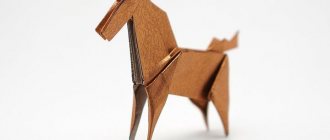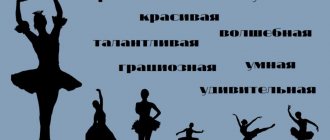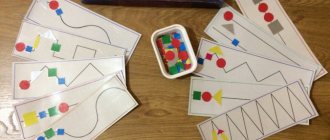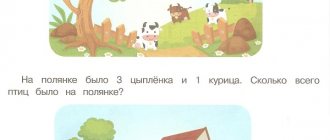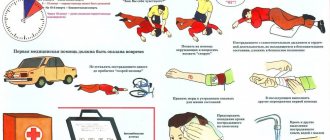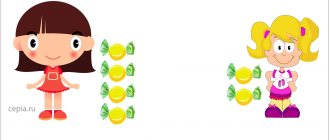Games “Who Lives Where” - project 1 day - 1 game.
- Seal
Details Author: Nalivaykina Lyudmila Published January 06, 2016
Hi all!
The “One Day - One Game” project is with you again! You can see what we played last weeks here!
This week our games will be dedicated to animals and their houses!
Ready? Then let's go!
Monday.
Let's start the week seriously! We will introduce the child to the topic “Who Lives Where!”
To begin with, I suggest you watch the presentation with your child, which you can download by clicking on the picture below.
It will be great if you can watch the presentation not only today, but several times throughout the week, so your child will better understand all the material (click on this picture ??? and you can download the presentation) .
Game after the presentation.
The child will understand the topic of the presentation very well if, after watching it, you build houses for the toy animals that you find in the house.
You can build a den for the bear and put it there for winter hibernation (wrap it in a blanket, cover it with pillows, etc.).
You can make a hole for a fox in the same way.
For a rubber fish, you can make a “sea” by pouring water into a basin.
If you think about it, you can come up with a “house” for any toy animal that you have at home!
The game “Build a house for an animal” is remarkable because children usually play it with great pleasure and it won’t take long to persuade them. At the same time, the child will not just play, but remember important and useful things: the bear’s house is called a den and he sleeps in it in winter, the fish lives in the water, etc.
How to learn the names of animals with your child
1) To begin with, an adult can simply tell the child about the habitats of animals, arrange the pictures correctly and name all the animals.
2) Then select any field and cards only related to it, invite the child to arrange them independently and name them.
3) Further complicate the classes, you can play lotto. The child himself chooses which animals he will collect, you take out the pictures from the bag, the child will name them and lay out the ones he needs on the field.
My son liked this game, he couldn’t even wait quietly for me to make it, he immediately joined the process. Look at the photo for yourself.
Good luck to you and your children in studying animals!
Educational game about animals - Who lives where?
Montessori Tuesday!
Look, these animals want to get home! Let's build a path for them! The bear has big legs, he will have the biggest pebbles on the path! The fox has smaller legs, the pebbles on its path will be smaller, but the squirrel has the smallest legs! Therefore, the pebbles on her path will be tiny!
The base of the path is made of dough, the “pebbles” are beans, peas, cereals (they are offered to the child in a mixed form so that he can independently dig into the cereal and look for the necessary “pebbles”). The picture can be found at the end of this post. During the game, do not forget to “pronounce” the names of the animals’ houses: we help the bear get to the “ den ,” the fox hurries to the “ burrow ,” the squirrel wants to get to the “ hollow .”
This game develops motor skills and mathematical thinking (we perform “sorting objects”), knowledge of the world around us.
Didactic game "Who lives where"
Didactic game “Who Lives Where?”
Target:
introduce students to wild and domestic animals, who lives where, develop memory, thinking, imagination, fine motor skills, develop the ability to correlate the image of an animal with its habitat, correctly naming the animal.
Tasks:
Educational:
Expand children's ideas about the appearance, image and dwellings of nature's inhabitants. Expand your vocabulary. Develop the ability to analyze, generalize and compare, and draw conclusions.
Developmental
: Formation of the ability to recognize the image of animals in the image, to correlate the animal with its habitat. Development of visual attention and memory.
Educational:
Developing an interest in nature, caring for nature and animals.
Description of the game.
The game consists of a circle
which is divided into 8 parts (with images of animals and 8 clothespins (with the habitat of animals).
Rules.
It is necessary to correlate the animal with its habitat.
Progress of the game.
The teacher asks the student to look at the pictures, what do you see in the pictures? (animals).What types of animals are there? (wild and domestic).
Wild animals live independently in nature: they get their own food, build their own homes.
Pets are animals that have been tamed by humans by caring for them and providing them with food.
-Guys, every animal has its own house, let's help each animal find its own house.
The teacher shows an animal and asks the question “what animal is this?”
( dog).
- Is this a wild or domestic animal (this is a domestic animal). Why do you think this is a pet? (she lives next to a person, helps a person guard his home, a person feeds a dog). Then the student is asked to find a house for the animal (the dog lives in a booth).
- Well done, guys, you answered correctly and found the dog his home.
The teacher shows the next animal and asks the student a question: (the picture shows a cat.
-A cat is a wild animal or a domestic animal (is it a domestic animal). Why do you think that it is a domestic animal? (students' answers).
The student is asked to find a house for the cat (the cat lives in a special carrier)
The teacher shows a picture of a wolf and asks the question: is the wolf a domestic or wild animal (students answer the question, is the wolf a wild animal, and explain their answer (the wolf lives in a den).
Students work in a similar way with other pictures:
A camel lives in the desert
Whale in the sea
Bear in a den
Horse in the stable
Caterpillar on the bottom of a leaf.
Thus, in the process of this game, vocabulary develops and enriches, memory, thinking, imagination develops, and fine motor skills develop. The game is interesting and exciting.
Thursday.
Let's develop memory in our kids! And it’s best to do this in the form of a fairy tale.
The essence of the game is as follows:
Show your child several toys, then hide one of them and ask the child to say which one is hidden.
But how can you “play” this with a child from 2 to 3 years old?
Indeed, some children will be happy to play this game, even if you don’t “drag” them into the process too much... But still, most children need to be “helped” to become interested... And it’s better to do this with the help of a fairy tale!
So:
1. Show the heroes of the fairy tale.
Once upon a time there lived a bird and a fox (I took these toys as an example, of course you will choose what you have. The main thing is that the baby can name them at your request (if the child says “moo-moo” to “cow”, and “moo-moo” to kitty) in general, any personal “word” is also accepted, the main thing is that you understand each other).
2. Add details so that the child remembers the characters better.
The bird loved to fly like this, and the fox ran after her like this (we say anything here, the main thing is to give the child time to remember the characters and draw his attention to each of them).
3. Hiding one of the toys.
But then the wind blew... (we cover the toys with something and quietly hide one of them) and took one of the animals...
5. Who is missing?
There was only one fox left in the clearing... Who did the wind take you to?
The child must answer who is missing... I played this game with many two-year-olds... If you choose the right toys (the names of which the kids can somehow reproduce with sounds (or replace them with “meow-meow”, “moo-moo”) and tell the story in an interesting way , then usually the guys manage to guess “who is missing.”
If you cope well with 2 toys, add new ones to the “fairy tale” (“and then a cow appeared in the clearing... moooo, what are you doing here? The fox answers “,,,,” and the bird “.... "... and then the wind blows again and again takes someone away... who?).
Friday - craft on the theme “Who lives where?”
You can download a template for the craft at the end of this post... Or draw it yourself (any adult can handle a tree and a squirrel, and it doesn’t matter that the squirrel looks more like a dog, this usually doesn’t bother children very much).
Here is a squirrel sitting on a branch near a hollow... (back to the topic again - “a squirrel lives in a hollow”; you can again discuss with your child that the hollow is a squirrel’s house).
Oh! Something is wrong with the tree! Yes, it doesn’t have leaves!
Let's draw some leaves for the squirrel!
Lubricate your child's hand with paint and show him how to make handprints on wood.
You will get very beautiful foliage!
I like to do similar crafts with children from 2 to 3 years old in 2 stages:
Stage 1 - first, we draw leaves on the tree together (the mother uses the baby’s palm to draw leaves using the “hand in hand” technique) - this is how the child gets acquainted with how to do the craft.
Stage 2 - after admiring the wonderful tree that you have created, we take out another picture with a tree and a squirrel and invite the child to “decorate the tree with leaves” again, but only on his own, without your help (you can only paint the child’s palm with paint, and he can draw the leaves he can already do it himself, since he “learned” this together with you at stage 1).
In my classes at the children's club, I often suggest that children who are over 2.5 years old paint their palms with paint on their own without the help of their mothers - they also really like it.
Didactic game “Who lives where?” lesson plan (junior group) on the topic
Didactic game
“Guess who lives where?” Goal: to develop children’s ability to correlate images of animals with their habitat, correctly naming the animal. Tasks: - explain to children what is depicted on the panel (For example: a house is depicted, which means a domestic animal lives here; the sun and unusual trees are depicted - this is a hot country; a fir-tree, a tree, a bush is depicted - this is a forest, wild animals live in the forest; a pond is depicted and cattail is a body of water in which frogs, fish, etc. live). - develop auditory perception and phrasal speech; - develop imagination when recognizing an animal. - be able, based on generalization, to correlate the image of an animal with the image of its habitat (in a pond, a domestic animal, living in the forest - a wild animal, living in a hot country); - develop the ability to express your feelings by speaking them out loud (soft, smooth, pleasant); — relieving emotional stress when feeling the pad. Preparatory stage: conversations about animals. Material used: panels depicting animal habitats; soft anti-stress pads depicting animals. Age: junior (2-3 years)
Progress of the game: The teacher draws the children’s attention to the panel. Invites children to look and say what they see. After the children’s statements, he explains: Guys, all animals have their own home. The place where he feels best. In another place he will feel bad and uncomfortable. Now I will tell you who lives and where. Pointing one by one to the image in the upper left corner: - Guys, what do you see, what is shown here? After listening to the children's answers, he continues. A house is shown here. This means that domestic animals live here - a dog, a cow, etc. What other domestic animals do you know? Children answer, and the teacher corrects correctly or incorrectly.
At the end, when all the animals are named and arranged according to their habitats, the teacher makes a generalization: - Guys, despite the fact that each animal has its own home, all animals live in a common house called Earth, like we have on our rug . The teacher, showing the animal, asks: “Who is it?” - the children guess. The teacher asks: “Where does he live?”... The child answers: “In the forest, this is a wild animal.” Asks to house this animal according to its habitat.
At the end of the lesson, the teacher lets the children play, knead the pad with their fingers and say that the children feel which pads are animals (soft, smooth, pleasant to the touch).
Saturday - play outside!
"Houses".
You have been studying the topic “houses” all week.
I suggest playing with this theme on the street on Saturday! Take some kind of toy with you for a walk and build a house for it: from twigs, leaves, or a sand hole.
This could be a nest for a bird, a hole for a mouse or a fox, or a den for a bear cub.
What this game will help you develop:
1. Design according to plan (we develop logic and design skills).
2. We continue to work on the topic of “who lives where” (we build a “mink” for a mouse, a “den” for a bear, etc.).
3. Developing speech (when playing with your baby, you, of course, communicate a lot, and since the game situation will be “new” (after all, you don’t build houses every day), several new and important words will definitely appear in the baby’s vocabulary).
"Playing with a house on the playground."
For this game you will need at least two adults; the second adult can be a dad, an older child, or another mother who is walking on the playground with her child.
Adults share roles among themselves, one will be a wolf, and the other will be a bunny. The kids who will participate in the game also become bunnies.
While the wolf is “sleeping” (squatting with his eyes closed), the little hares are jumping near the house. As soon as the wolf “wakes up”, he begins to catch up with the bunnies, and the bunnies hide in the house.
Sunday - we play house.
Sometimes adults think that if they play happily with a child, then this is just pampering and will certainly not pass for development. But in fact, even in the most simple games, the child also develops. The main thing is that he plays with pleasure and takes an active part in them!
That is why Sunday in the “One Day - One Game” project is traditionally proclaimed a day of fun games with the whole family.
What will we play this Sunday? To the houses!
Build a house in your apartment with your child. This house can be made from anything! Maybe it will be a blanket thrown over the table, and the house itself will be located under it?
Or will you build a cozy den out of chairs, throws or pillows?
Try to come up with something of your own and involve your child in building the house!
Well, when the house is ready, play in it with your child! Climb into the house, hiding there “from the wolf”, collect “nuts and cones” around the house and drag them “into the house” - make supplies, arrange your house so that there is everything you need for life - children’s dishes, a pillow for sleeping and so on.
Of course, not every 2-year-old child will be able to consciously and enthusiastically play “house” on their own. But if you play with him (and maybe involve other family members in the game), the baby will be incredibly happy and will be happy to participate in this game.
What does the house game develop:
1. The child learns to play. A child who does not know how to entertain and occupy himself is a big problem for parents. By playing with him, you prepare him to be able to play independently, and also to participate in the games of other children or invent them himself.
2. The child learns to build something.
3. While playing, you communicate a lot, and this helps the child develop vocabulary and master speech.
4. By communicating with parents, the child develops as a person. Of course, you communicate a lot during the day, but communication in a game is one of the most enjoyable types of communication that children simply adore.
OK it's all over Now! Another week of fun and useful games with your child is over!
Play and develop easily and with pleasure!
You can download materials for the week using this link (click on the picture):
The topic is “Who Lives Where?” classes in kindergarten
SAMPLE SUMMARY OF A SUB-GROUP LESSON ON FORMATION OF CONNECTED SPEECH (SCHOOL PREPARATORY GROUP)
Municipal budgetary preschool educational institution kindergarten "Solnyshko" Nikiforovsky district, Tambov region
The topic is “Who Lives Where?”
prepared by - teacher - speech therapist Seredina Nelly Aleksandrovna, r.p. Dmitrievka
Objectives of the lesson: - To consolidate knowledge about wild animals, to introduce them to their homes. — Expand and activate vocabulary on the topics “Wild Animals”, “Winter”. — To develop practical skills in the correct use of relative adjectives, to consolidate the ability to coordinate nouns with adjectives. — Clarify the lexical meaning of the words: chest, casket, donut, tower, fly. — Develop skills of connected statements, cognitive abilities, imagination, creativity. — To form an ecological culture, to cultivate a sense of beauty.
Equipment:
Tape recorder, disc with recording of music by P.I. Tchaikovsky "Seasons"; items for the “winter forest”: artificial spruce trees, stumps, branches, cotton wool, snowflakes, white paper (road with hare tracks), a basket with nuts and cones, soft toys: bear, hare, squirrel, wolf, hedgehog, fox; flannelograms (boards) (one large and two small); painting material (wild animals, their homes, two or three Christmas trees, bushes, the sun, snowdrifts, clouds, snowflakes, etc.), bunny masks.
Lexical material:
- nouns: squirrel, bear, fox, hedgehog, hare, wolf, dwelling, woodpecker, hollow, hole, den, lair, crown; - adjectives: wild, squirrel, bear, fox, hare, wolf, clubfoot; - verbs: settle, insulate, hollow out.
Organizing time
Speech therapist. Today guests came to our lesson. Guess who? Jump-hop along the trees, Yes, nuts click-click. Children. A squirrel came to us.
After each answer, the speech therapist puts a picture of an animal on the flannelgraph (board).
Speech therapist. How did you guess? Children. The squirrel eats nuts. She is fast and jumps easily. Speech therapist. In summer he walks with a clubfoot, and in winter he sucks his paw. Children. Bear. Speech therapist. How do you understand the word clubfoot?
Children offer options for the lexical meaning of a given word, which are usually inaccurate. The speech therapist explains: “To walk with a clubfoot is to step with your heels apart, awkwardly, awkwardly.”
Speech therapist. Red-haired, cunning, steals chickens. Children. Fox. Speech therapist. What does cunning mean? Children. Smart. She is deceiving everyone. The fox hides her intentions (desires). Speech therapist. The creeper crawls, carrying needles on itself. Children. Hedgehog. Speech therapist. What else can you say about the hedgehog? Children. It has prickly needles. He eats apples. In winter it sleeps for a long time. Speech therapist. Long ear, ball of fluff, jumps deftly, loves carrots. Children. Hare.
Speech therapist. What else can you say about the hare? Children. He changes his fur coat; in winter it is white. The hare is afraid of everyone. Speech therapist. Who walks around angry and hungry in the cold winter? Children. Wolf.
Speech therapist. Why do I call these animals wild? Children. They live in the forest and are afraid of humans. These are untamed animals.
Message of the topic of the lesson : Speech therapist. Now we will continue the conversation about wild animals and their homes. How do you understand the word dwelling? Children offer options for the lexical meaning of a given word, which, as a rule, are inaccurate. The speech therapist explains: “Dwelling is a place where animals live away from human habitation.” You know the names of some animal dwellings. But we’ll see what they look like in a fairytale forest.
Main part
1. Conducting a psycho-gymnastic sketch
Music is playing
Speech therapist. Close your eyes and imagine everything I am going to tell you about. Winter is on the street. Everything around is white and white. The snow sparkles in the cold and crunches underfoot. We got on our skis and went into the forest. It's quiet in the forest. The branches of the trees became heavy with snow and sank down. The trees are like something out of a fairy tale: fluffy snowflakes cling to all the branches. The crown (the so-called upper part of the tree) is all dazzling white, only the trunk darkens against the background of fluffy snow. As soon as the breeze blows, the snow begins to fall off the branches. And it's so beautiful. Now, children, let's open our eyes. I'll tell you a secret that a small corner of a fairytale forest is located next to us.
The children, together with the speech therapist, go to another room where a “winter forest” has been created.
Take a closer look and listen. What do you see? What do you hear? Children. It's quiet here. There are green Christmas trees strewn with snowflakes. There are birds in the trees. A squirrel sits in a hollow.
The music stops. Speech therapist. Where? Show it to me. What is the name of her house? Children. Her house is called a hollow. Speech therapist. A squirrel cannot hollow out a hole for itself. Where does this hollow come from? How do you think? Children. Another squirrel lived there. A squirrel found a home in an old tree. Speech therapist. Squirrels settle in the hollow left by the woodpecker. They insulate it with moss, dry leaves and grass. (He opens the basket, overturns it, nuts and small pine cones roll out in the “snow.”) Oh! What have I done. Where do you think this comes from? Children. These are squirrel reserves for the winter. She collected it herself. Speech therapist. Take a nut or cone and place it on your palm. Consider them.
2. Carrying out finger exercises and exercises to prevent visual impairment
Speech therapist. Let's play with nuts (cones). Children squeeze nuts (cones) into their fists (5-10 times), roll them between their palms (up and down, left and right), make circular movements on their palms, then extend their right arms, hold these objects with their thumb and forefinger and slowly move their arms away right, left, make circular movements with their hands and carefully follow the movement of the object with their eyes, without turning their heads.
Speech therapist. You did very well. Place the nuts and cones in a basket and leave them for the squirrel. Now look, what is this? (Puts out a picture.) Speech therapist. Guys, look, what is this? Children. This is a hole. We see the fox's tail. This is the fox's house. Speech therapist. This is a fox hole. Let's repeat the name of the fox's house. Children pronounce the sentence in chorus and individually. Speech therapist. What is the name of the bear's home? Children. Den. Speech therapist. Let's fantasize and imagine how a bear builds a den? Children. A large tree fell and the bear crawled under it. It's a big hole with branches on top. Speech therapist. I accept your answers and agree with you in many respects: the bear makes a den in a large hole, always in a dry place, along an upturned tree with roots, and falls asleep there. Where do you think the bear is located in our “forest”?
The children point to a large “snowdrift”. Speech therapist. But we won’t disturb the bear; let him sleep in his den. Who else sleeps in winter? Children. Hedgehog. Speech therapist. What kind of home does a hedgehog have? Children. He sleeps in the leaves. Speech therapist. Hedgehogs sleep for six months. They crawl under a pile of leaves, grass, branches, and sometimes under the roots of old trees. Now look, what are these traces? (Puts out a picture.) Children. These are traces of a fox and a hare. Speech therapist. Right. Now we will turn into bunnies and jump in the rabbit's tracks. I think they will lead us to the hare's house.
3. Dynamic pause Children put on hats with ears and jump in the rabbit's tracks. Speech therapist. Where do you think the hare is? Why is he not in his home? Children. The hare ran away. He's afraid of everyone. He doesn't have a home. Speech therapist. Hares do not build permanent homes for themselves. They are resting, sleeping under a bush. In winter they can hide in a snow hole. The holes and bushes are different every time. Let's get away from this bush. Maybe the hare got scared of us and that’s why it ran away. The “bunny” children jump to another “tree” and take off their hats. Speech therapist. What animal's home have we not named? Children. We did not name the wolf's home. Speech therapist. The wolf's home is called a lair - a small hole, there is a lot of grass, leaves, and twigs in it. From above it is covered with branches, old twigs, so the snow does not fall into the hole. The wolf in the den sleeps, hides, rests. What is the name of a wolf's home?
Children answer in chorus and individually. Speech therapist. Our journey has now ended. It's time to return to the group. What did you like about our “forest”, on our journey? Children. The hollow in which the squirrel lives. How we turned into bunnies. The children say goodbye to the “forest” and go to another room. Speech therapist. Children, go to the table, take the drawn homes of wild animals and attach the house of each animal to the board. Now you need to answer my questions one by one in a complete sentence. Where does the fox live? Children. The fox lives in a hole. Speech therapist. So whose hole is this? Children. This is a fox hole. Speech therapist. Where does the squirrel live? Children. The squirrel lives in a hollow. Speech therapist. Whose hollow? Children. This is a squirrel hollow. Speech therapist. Where does the bear live? Children. The bear lives in a den. Speech therapist. Whose den is this? Children. This is a bear's den. Speech therapist. Where does the hare live? Children. The hare has no home. He lives under a bush. Speech therapist. Where does the hedgehog live? Children. The hedgehog hides for the winter in dry leaves and grass. Speech therapist. Guys, I propose to create a fairy forest on the board. Children take picture material (Christmas trees, snowflakes, clouds, etc.) and attach it. Speech therapist. I love. And you? Let's come up with a name for our picture. Children. We like it too. In the forest. Fairy forest. The forest is a home for animals. Result of the speech therapist lesson. Do you think it’s good for animals to live in the forest? Children. Fine. They feel comfortable there. The forest feeds them.
Speech therapist. How should people behave in the forest? Children. You cannot break anything in the forest or chase insects and animals. We must protect beauty. The forest must not be polluted. Speech therapist. You made me happy with your answers. Each of you is different in some way: Polina, Vika know a lot about animals; The answers to questions from Sasha and Egor were interesting; Dima spoke very interestingly about the bear’s home. You knew how to listen to your friends’ answers, you were friendly, so let’s give each other a smile when we say goodbye. Goodbye.
The story on the board remains in the group for 2-3 days. The teacher consolidates the studied material and works to form the psychological basis of speech.
I want to say goodbye but not for real:
I am very, very sorry to write this, but what can you do! I have to!
I really wanted to extend the project over the whole year, the idea was amazing! But during its implementation, I realized that sometimes it is difficult for me to post once a week (work in a children’s club, motherhood and my own life are hectic... so I don’t have time for everything).
Therefore, I decided not to close the project, but to make it less regular! (I will post new weeks in this project as soon as possible, but not every week).
Many thanks to everyone who participated and played the games and inspired me with their reviews and comments! Without your support, I would write less cheerfully! Thank you very much!

